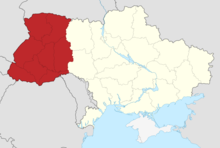
Back غرب أوكرانيا Arabic Qərbi Ukrayna Azerbaijani Заходняя Украіна Byelorussian Заходняя Ўкраіна BE-X-OLD Ucraïna Occidental Catalan Západní Ukrajina Czech Анăç Украина CV Vestukraine Danish Westukraine German Ukraynay Rocawani DIQ
| Western Ukraine | |
|---|---|
 Regions that are included in the West of Ukraine | |
| Area | |
| • Coordinates | 50°N 26°E / 50°N 26°E |
 Map of the Kingdom of Galicia–Volhynia in the 13th/14th century | |



Western Ukraine (Ukrainian: Західна Україна, romanized: Zakhidna Ukraina)[6] or West Ukraine refers to the western territories of Ukraine. There is no universally accepted definition of the territory's boundaries, but the contemporary Ukrainian administrative regions (oblasts) of Chernivtsi, Ivano-Frankivsk, Lviv, Ternopil and Zakarpattia (which were part of the former Austro-Hungarian Empire) are typically included. In addition, Volyn and Rivne Oblasts (parts of the territory annexed from the Polish–Lithuanian Commonwealth during its Third Partition) are also usually included. It is less common to include the Khmelnytskyi Oblasts in this category. It includes several historical regions such as Carpathian Ruthenia, Halychyna including Pokuttia (the eastern portion of Eastern Galicia), most of Volhynia, northern Bukovina and the Hertsa region, and Podolia. Western Ukraine is sometimes considered to include areas of eastern Volhynia, Podolia, and the small northern portion of Bessarabia.
The area of Western Ukraine was ruled by various polities, including the Kingdom of Galicia–Volhynia, which became part of the Polish–Lithuanian Commonwealth, but also the Principality of Moldavia; it would then variously come under rule of the Austrian Empire, Austria-Hungary, the Second Polish Republic, the Kingdom of Romania, and finally the Soviet Union (via the Ukrainian Soviet Socialist Republic) in 1939 and 1940 following the invasion of Poland and the Soviet occupation of Bessarabia and Northern Bukovina, with the borders finalized after the end of World War II. After the dissolution of the Soviet Union, it became part of the independent Ukrainian state.
Western Ukraine is known for its exceptional natural and cultural heritage, several sites of which are on the List of World Heritage. Architecturally, it includes the fortress of Kamianets, the Old Town of Lviv, the former Residence of Bukovinian and Dalmatian Metropolitans, the Tserkvas, the Khotyn Fortress and the Pochayiv Lavra. Its landscapes and natural sites also represent a major tourist asset for the region, combining the mountain landscapes of the Ukrainian Carpathians and those of the Podolian Upland. These include Mount Hoverla, the highest point in Ukraine, Optymistychna Cave, the largest in Europe, Bukovel Ski Resort, Synevyr National Park, Carpathian National Park or the Uzhanskyi National Nature Park protecting part of the primary forests included in the Carpathian Biosphere Reserve.[7]
The city of Lviv is the main cultural center of the region and was the historical capital of the Kingdom of Galicia–Volhynia. Other important cities are Chernivtsi, Rivne, Ivano-Frankivsk, Ternopil, Lutsk, Khmelnytskyi and Uzhhorod.
- ^ Perfecky, George A. (1973). The Galician-Volynian Chronicle. Munich: Wilhelm Fink Verlag. OCLC 902306
- ^ "Kam'ianets-Podilskyi historical". kampod.name (in Ukrainian). Archived from the original on 2011-04-30. Retrieved 2011-05-10.
- ^ Bochenek 1980, p. 93.
- ^ Welcome to Ukraine: About Kamianets-Podilskyi Archived 2013-05-13 at the Wayback Machine MIBS Travel
- ^ A trip to historic Kamianets-Podilskyi: crossroads of many cultures Archived 2016-03-04 at the Wayback Machine, Roman Woronowycz, Kyiv Press Bureau.
- ^ "ЗАХІДНА УКРАЇНА, ЯК ТЕРМІН". resource.history.org.ua. Archived from the original on 2022-01-23. Retrieved 2022-03-23.
- ^ UNESCO: Carpathian, July 2011
© MMXXIII Rich X Search. We shall prevail. All rights reserved. Rich X Search